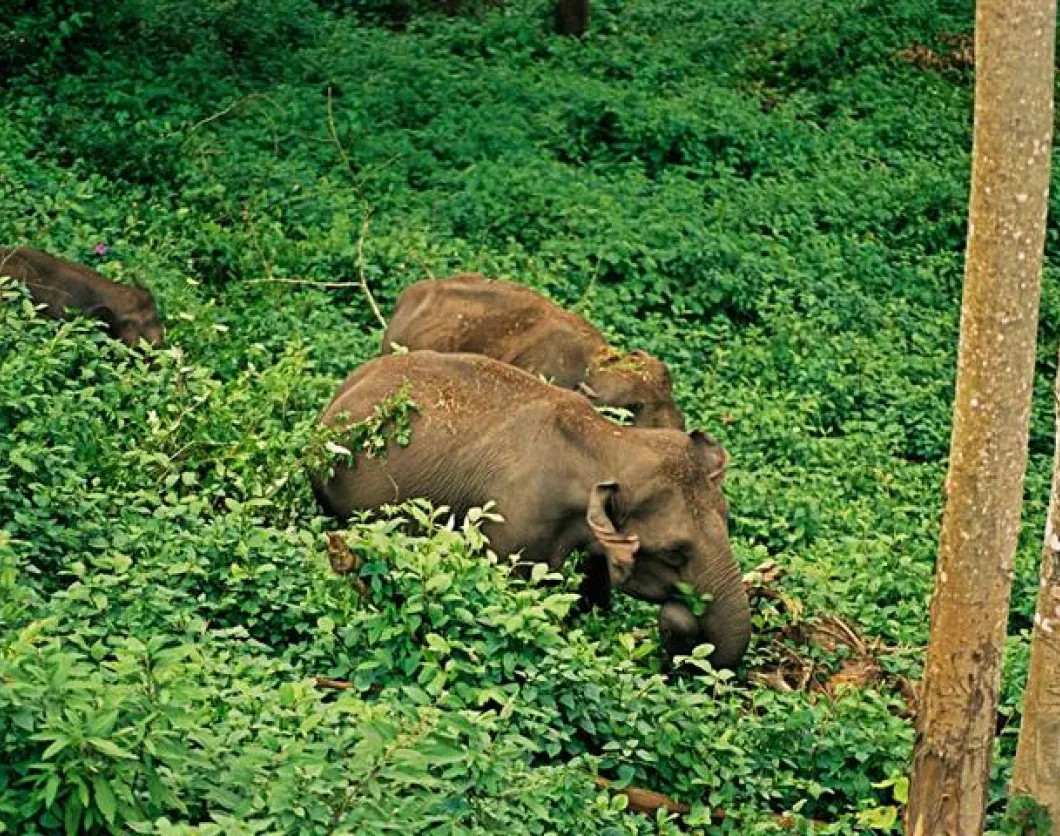The Western Ghats, a UNESCO site since 2012, sustain livelihoods of about 50 million of the 1 billion people in India. Except the Indo-Malayan region, no other biodiversity hotspot impacts so many. Historically, well-covered in forests providing food and natural habitat for its natives, inaccessibility made it difficult for the plainsmen to cultivate and construct. The British cleared territories for plantations (tea, coffee, rubber, eucalyptus, teak) affecting species. Increasing population stressed protected area fringes from loggers and illegal poachers. Human-wildlife conflict, elephants raiding crops, leopards killing livestock, grazing cattle causing erosion and deforestation for reservoirs, roads and railways are common. Presently, 20% of the pristine cover has forests above 200 km² (Cardamom Hills and Silent Valley). Elsewhere, are pressures from hunting, extraction of fuels, non-timber products and uncontrolled tourism.
The Western Ghats or Sahyadri run parallel to the coastal plain (Konkan) along the Arabian Sea, about 30-50 km inland India. Covering 160,000 km², it stretches N-S for 1,600 km from the southern tip of Tamil Nadu onto Kerala, Karnataka, Goa, Maharashtra and Gujarat.
Older then the Himalayas, the Great Escarpment is the faulted edge of the Deccan Plateau formed during the Gondwana super-continent’s breakup, 150 million years ago. Their Outstanding Universal Value is manifested in its unique and fascinating influence on large-scale biophysical and ecological processes on the peninsula.
The Ghats (1,200 m) intercept the moisture laden, south-westerly, tropical monsoon winds causing 3,000-4,000 mm rainfall on the western, windward slopes (June-Sept.). Dense forests act as a substrate for condensation of sea winds by releasing moisture via transpiration and condensing to rainfall.
Climate varies with altitude - humid and tropical in the lower reaches and temperate with frosts and sub-zero temperatures in higher elevations (1,500-2,000 m) in the Matheran, Lonavala, Mahabaleshwar, Kudremukh, Kodagu and Munnar hill stations.
The Western Ghats form the catchment of a riverine system draining almost 40% of India through some of the biggest perennial rivers - Godavari, Krishna and Kaveri flow /east (Bay of Bengal) and the Periyar, Netravathi, Mandovi and Zuari into the Arabian Sea. The steep gradient forms waterfalls (Jog, Sivasamudram) while the slopes make sites for hydro-electric projects (Koyna, Parambikulam, Idukki).
Dams provide supply for drinking water and irrigation. Ooty, Kodaikanal and Pookode lakes attract tourists for scenery, boating and fishing. Rainfall and terrain variations make the Ghats biologically diverse. Scrub forests dominate low-lying, rain shadows. Moist deciduous forests and tropical evergreen rainforests exist elsewhere. Above 1,500 m is a mosaic of ecologically diverse montane forests with orchids, seasonal flowers, fresh water Myristica swamps and shola grasslands rich in medicinal plants, fruit and spices.
Recognized internationally as a region of immense global importance for their exceptional natural heritage, endemism, cultural and aesthetic values the Western Ghats are one of the eight ‘hottest hotspots’ of biological diversity in the world with globally threatened and restricted species in significant numbers. They cover 6% land area and are home to 30% of plant, reptile, fish, bird and mammals in India.
The 325 globally threatened flora and fauna are represented by 229 plants, 31 mammals, 15 birds, 43 amphibians, 5 reptiles and 1 fish species. Of these, 129 are Vulnerable, 145 Endangered and 51 Critically Endangered. The level of plant endemicity is high with 325 trees, 1,700 vascular plants and 130 orchid species.
30% of the world’s Asian elephants exist here (particularly, in the Nilgiri Bio-sphere and Project Elephant Reserve) and 17% of the world’s Indian tigers (outside Sundarbans). Flagship mammals are the endangered lion-tailed macaque (Silent Valley), Nilgiri tahr (montane grasslands), gaur (Bandipur and Nagerhole National Parks), Indian muntjac (Bhadra Wildlife Sanctuary) and the critically endangered large-spotted civet (Malabar plains). Leopards, black panthers, sambars, sloth bears and wild boars hide in canopies. Among 50 bat species, the Wroughton's free tailed, Theobald's tomb and Lesser False Vampire are endangered. The arboreal, bush-tailed, rufous Malabar Giant Squirrel balances on tree tops. Diverse land snails are abundant.
Of equally diverse amphibians, about 80% are endemic. The Bronzed frog on stream edges, Blue-eyed bush frog, Ponmudi bush frog (after the Kerala hill station), Malabar gliding frog and endangered purple frog (discovered here in 2003) are all natives. Amphibians fare high levels of threat (20 recorded extinctions) from habitat loss. Reptiles include the green vine snake, Malabar pit viper and the flagship King Cobra, the world’s largest venomous snake besides Forest Calotes lizards. Of 450 bird species, 35 are endemic and 10 threatened, including the green-billed coucal, Malabar whistling thrush, rufous-breasted laughing thrush, spot-billed pelican, lesser adjutant stork and Kashmir flycatcher.
The Malabar Pied Hornbill, Scarlet Minivet, Nilgiri Wood-pigeon, Malabar Parakeet, Grey-headed Bulbul, Crimson-backed Sunbird, Golden-Backed Woodpecker and Crested Hawk Eagle exist. Among invertebrate species, 100 of (140) tiger beetles and 37 (300) butterflies are endemic.
India has a history of reverence for nature, conservation, environmental legislation and a strong civil society. The Western Ghats have stringent protection regimes under the Wildlife Protection Act (1972) and the Forest Conservation Act (1980). The State Forest Department’s conserve biodiversity, ensure social forestry and protect endangered species. NGO’s involve communities in sustainable resource utilization and participation in Village Eco Development Committees. WWF’s Biodiversity 'Hotspots' Conservation Programme (1993-2005) identified and mapped critical wildlife corridors and key species, mitigated human-animal conflict, strengthened protected areas, promoted sustainable livelihoods and involved Government-civic body partnerships. 126 Key Biodiversity Areas were identified and delineated (2003) to protect threatened species. The Western Ghats Ecology Expert Panel designated an Ecologically Sensitive Area (2011) assigning three levels of sensitivity.
Since 2012, 39 properties (20 in Kerala, 10 in Karnataka, 5 in Tamil Nadu, 4 in Maharashtra), has been designated as a UNESCO World Heritage Site encompassing 14% of the hotspot is officially protected in 20 national parks and 68 wildlife sanctuaries (11 % of which is in IUCN’s I-IV categories) while 40% is under Reserved Forests. Integrating their management and coordination is challenging at the Centre, State and sites. As home to several rivers, plants and animals, the loss of the Ghats will have far reaching consequences beyond comprehension.
By Ilika Chakravarty
Academy of Business Management, Tourism and Research, Bangalore, India
63 Ferry Street, Horseshoe Close, London, E14 3DT, U.K.
ilika.chakravarty@gmail.com












